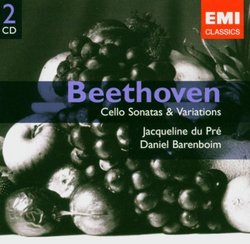| All Artists: Ludwig van Beethoven, Daniel Barenboim Title: Beethoven: Cello Sonatas & Variations Members Wishing: 0 Total Copies: 0 Label: EMI Classics Release Date: 2/15/2005 Genre: Classical Styles: Chamber Music, Historical Periods, Classical (c.1770-1830), Instruments, Strings Number of Discs: 2 SwapaCD Credits: 2 UPC: 724358624229 |
Search - Ludwig van Beethoven, Daniel Barenboim :: Beethoven: Cello Sonatas & Variations
 | Ludwig van Beethoven, Daniel Barenboim Beethoven: Cello Sonatas & Variations Genre: Classical
|
Larger Image |
CD Details |
CD ReviewsBeethoven for Cello and Piano Robin Friedman | Washington, D.C. United States | 08/06/2008 (5 out of 5 stars) "Many listeners who know Beethoven's symphonies, concertos, piano sonatas, or quartets are unfamiliar with his five sonatas for cello and piano. But this genre finds Beethoven at the top of his form. Even though Beethoven composed only five of these works, he wrote them during each of his major styles, from the early works of opus 5, to the great middle-period work, opus 69, and to the final two sonatas of opus 102, similar in style to the late piano sonatas and quartets. Only the symphonies, string quartets, piano sonatas, and the five cello sonatas show Beethoven in all three of his "manners" of composition. The cello sonatas show Beethoven at his best in each period.
Beethoven was the first major composer to write sonatas for cello and keyboard. His closest predecessor was Mozart in his sonatas for piano and violin. Beethoven struggled to free the cello from the role of an obligato instrument and to allow it to sing in its own voice together with the keyboard. His sonatas show his efforts to balance the two highly different instruments with an increasing degree of mastery. The cello and piano sonatas have been recorded extensively over the years. This two-CD set features the great cellist Jacqueline Du Pre together with Daniel Barenboim on the piano. It includes Beethoven's three sets of variations for piano and cello, two on themes by Mozart and one on a theme by Handel, together with the sonatas. The disk captures live performances from 1970 and includes the coughs and annoying background sounds that accompany a live performance. But the partnership between the musicians is of course intimate and the playing spirited. I own the higher-priced release of this CD rather than this budget reissue. The price is an extra attraction to the inspired music and performances. In relistening to this CD, I learned a great deal from Lewis Lockwood's discussion of the sonatas in his biography of Beethoven (2003) and from the program notes. Beethoven's two opus 5 sonatas date from 1796. Beethoven dedicated them to the pioneering cellist Pierre Duport. He and Duport first performed the sonatas for the Emperor of Prussia to great acclaim. Both these works open with a lengthy slow introduction followed by an allegro sonata movement and a concluding rondo. Beethoven handles the instruments differently in each work. In the first sonata in F major, the piano and cello tend to state alternately each theme. In the second and more sophisticated sonata in G minor, the piano and the cello more often have their own separate musical lines -- as opposed to their alternate repeating of the same theme. The second sonata features as well an engaging, sprightly rondo finale, one of the finest efforts of Beethoven's early years. The middle-period sonata in A major, opus 69, is one of Beethoven's masterworks in any genre. He wrote this work in 1807 -1808 at about the time of the Fifth Symphony. This work shares many resemblances to the middle period symphonies, quartets, and piano sonatas, especially the first opus 59 quartet and the "Waldstein" sonata. This is a sonata with both melody and passion. It opens with a brief cello solo followed by a tightly constructed allegro movement. The second movement is a lengthy highly rhythmic scherzo with the trio section occurring twice. The final movement opens with a beautifully lyrical short slow introduction followed by an exhilarating rondo. In this sonata, the cello and the piano are equal partners. The final two sonatas of opus 102 were composed in 1815 contemporaneously with the piano sonata opus 101. They show Beethoven already deep into his third period of composition. The sonata in C major in particular is a complex, difficult work with many resemblances to the opus 101 sonata. It is full of changes in tempo, themes, and styles, yet the work flows seamlessly. The opening slow introduction is followed by a jagged allegro. The second movement begins with a short adagio followed by a reprise of the opening material -- as in the opus 101 piano sonata -- and an allegro which picks up force as it develops. It was accurately said of this work at its early performances that "It is so original that no one can understand it on first hearing." The final sonata in D major is more immediately accessible tnan its companion. In the first movement, Beethoven takes a brusque phrase in the cello and extensively develops it. The second movement is a lengthy slow movement of the depth found in many other late period works, such as the "Hammerklavier" sonata. The finale, again in common with much late Beethoven, is a bristling fugue with one voice in the cello and three voices in the piano. The three sets of variations are delightful to hear, but they are not of the same magnitude as the five sonatas. Listeners wanting to explore Beethoven's extraordinary way with the cello and the piano will love this CD. Robin Friedman " |

 Track Listings (9) - Disc #1
Track Listings (9) - Disc #1